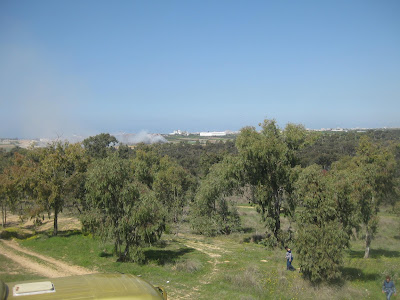The 23rd annual international tourism fair ( the full name of IMTM - International Mediteranean Tourism Market) was held at the Tel Aviv Trade Fair and Convention Center on 7-8 February.
The IMTM event is mainly for professional bodies in the field of tourism ( tour operators, tourist agencies. cruise lines, airlines companies , hotels etc...). It consists of presentations, seminars, workshops, conferences. Around 16:00 oclock, however, it opens for a couple of hours, for the large public to have a glimpse at the booths representing some 50 countries and get information on various touristic destinations.
visitors at the various booths
As it was a warm, nice day I went there on Tuesday, the 7th of Feb. to wander around in the large pavilion and see what was new.
For me, the fair was a good opportunity to get some Free city and regional quality tourist maps, and enjoy a few attractions offered at the various booths. Well, I got my maps and even more than that; at the Lithuania stand I was given a small gift of coasters and a wooden pen. At the "Israir" Group stand, I got to refreshen my suitcase identity tags with new ones, provided freely,of course. Some of the booths (Vietnam, China ,Ruanda ...) displayed a few handcrafted items specific to the country they represented.
Ruanda - nice handcraft items displayed on the desk
As for attractions, Romania, for example, brought a young folksinger and a saxophonist . Very good idea of attracting people's attention. I've greatly enjoyed their musical show. As I was born and raised in that country, it naturally brought back some memories.
the folksinger and the saxophonist at Romania booth
Panama had a couple of women dancers in extravagant dresses
Panama dancers
Panama joy
At the USA stand there was a tall guy dressed as an Indian, and at the Slovenia stand, an elderly man dressed in an historical outfit of the austro-ungarian epoch. The israeli city of Nazareth came up with some village dressed people.
the USA "Indian"
heavy, historical outfit at Slovenia booth
villagers from Nazareth area
At some stands, the hosts were dressed in traditional costumes
or had some traditional motifs introduced in the booth decoration.
the Moldova stand
Belarus - traditional shirt and cake
At the Dominican Republic's place there were four round little tables with satin white maps featuring the printed map of the country. Lovely sight!
round table - white map with the country's map printed on it
The israelis had, among other exhibits, some product samples at their booths: cosmetics from the Dead Sea , food from the Galilee and other regions of the country.
cheese and olives from the Galilee
I was nicely impressed by the fact that a tiny, almost hidden country like Albania had quite a few people approach the stand and ask for information about tourism there.
Albania booth
As I said, I was mainly looking for maps, but there was a lot of other kind of interesting stuff there as well. For example, it appears that many countries are interested in wellness tourism. So, there was a multitude of pamphlets describing Spa resorts and their conditions (prices, accomodation, medical supervision).
Information on tourist possibilities was given not only in paper format but also on CD-s.(I've got myself the discs of Istanbul and Kenya). I asked for some info on a certain area in Ukraine , and I was given very detailed oral explanation in addition to the displayed written one.
Turkey usually gets a great deal of israeli tourists, so I was not surprised to see its tourism factors fully represented at the Exhibition.
turkish airlines booth
A visit to such an event as IMTM allows one to feel 'the world in a nutshell', as they say, and it's quite an enriching experience.

























































